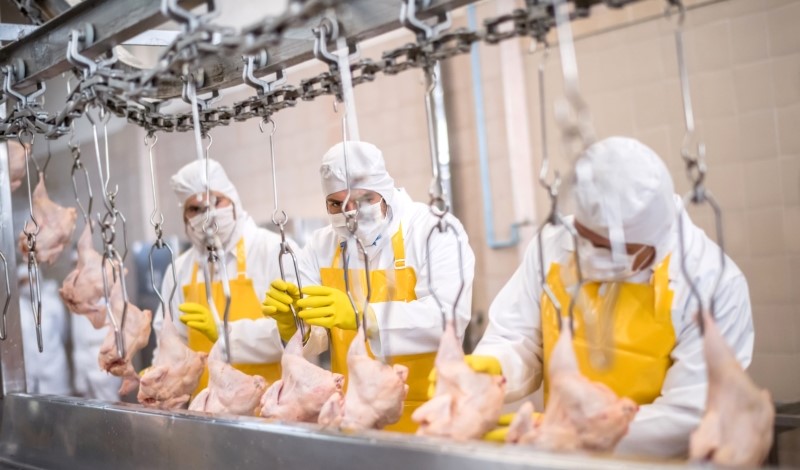
Scholars explore line speed and worker safety regulations governing meatpacking and poultry plants.
The average American eats about 100 pounds of chicken each year. To prepare chickens for consumption, the poultry industry relies on a largely automated process in which live chickens are killed, disemboweled, inspected, defeathered, and cleaned.
Despite prevalent automation, workers still face safety risks at each stage of the poultry slaughter process, including catching their limbs in machinery, cutting themselves with knives and other sharp objects, and developing stress injuries from repetitive tasks.
Many consumer advocacy groups contend that a poultry plant’s “line speed”—the rate at which workers process chickens—impacts its workers’ health and safety. The U.S. Department of Agriculture’s Food Safety and Inspection Service (FSIS) has limited most poultry plants to a maximum line speed of 140 birds per minute since 2014. Even at that speed, however, industry experts observe that workers suffer high injury rates.
Nevertheless, in 2018, the Trump Administration offered temporary line speed waivers to 54 poultry plants, allowing them to raise their line speeds to 175 birds per minute. Before former President Donald J. Trump left office, his administration also proposed a rule that would have raised FSIS’s line speed limit from 140 to 175 birds per minute.
President Joseph R. Biden withdrew the proposed rule shortly after entering the White House, garnering praise from workers’ rights advocates. These advocates argue that higher line speeds throughout the poultry industry would have compromised the health and safety of a mostly Black, Latinx, and immigrant labor force already working long shifts in close quarters during the COVID-19 pandemic. The Biden Administration, however, stopped short of withdrawing the temporary line speed waivers, and even extended the waivers recently through mid-November.
Even before the waiver extension, consumer groups had accused the Biden Administration of bowing to industry pressure by continuing to allow some plants to operate at elevated line speeds. These groups have also expressed doubts that FSIS’s planned study of line speeds’ impacts on worker safety would reveal information not already widely understood—namely, that workers require stronger workplace protections and that higher line speeds increase injury risks.
Meanwhile, other industry players, such as beef and pork processing companies, have also pushed the Biden Administration to increase line speeds in their plants despite critics’ concerns about potential injuries.
In response to claims that higher line speeds undermine worker safety, the National Chicken Council, a poultry industry lobbying group, has pointed out that other countries permit faster line speeds than the United States. Industry experts have countered, however, that it is difficult to make an “apples-to-apples” comparison with those countries. European plants, for example, tend to be smaller than their American counterparts. European workers also have higher unionization rates, and regulators enforce longer breaks and more interventions against repetitive stress injuries. Accordingly, some labor and health researchers note that the relationship between line speeds and worker injuries must be understood in the context of the U.S. federal government’s relative lack of workplace safety regulations enforcement.
In this week’s Saturday Seminar, scholars assess workplace safety issues in meatpacking and poultry plants.
- Racialized myths about Black and Brown workers drove meatpacking companies’ disregard for worker safety during the pandemic, Sherley E. Cruz of the University of Tennessee College of Law argues in an article in the Tulane Law Review. Despite the risk of infection, Cruz notes that during the COVID-19 pandemic, meatpacking companies increased worker density to meet production demands. She observes that immigrants and people of color comprised over half of the meatpacking workforce. Cruz contends that some meatpacking plant managers felt they could exploit nonwhite workers whom they believed could handle working under the pain of COVID-19 symptoms. Cruz recommends that the Occupational Safety and Health Administration (OSHA) communicate with employers and workers to better enforce workplace safety protections.
- In a Note in the Duke Law Journal, practitioner Johnathan Hall argues that Justice Neil Gorsuch’s proposed test for adjudicating nondelegation doctrine challenges would undermine the U.S. Congress’s ability to delegate policy decisions to federal agencies, including judgments concerning poultry inspection and safety. Hall notes that under the test Justice Gorsuch articulates in his Gundy v. United States dissent, Congress could delegate fact-finding to the Executive Branch, but not “policy judgments.” Hall applies the “Gorsuch test” to assess recent changes to the poultry slaughter inspection system. He finds that using this test would hurt consumers and regulated poultry companies by undermining federal efforts to update poultry safety standards based on technological changes and improved poultry breeding and management techniques.
- The Department of Agriculture’s decision to revoke some pig slaughterhouses’ line speed limits will cause environmental harm, Dani Replogle of Food and Water Watch and Delcianna L. Winders of Vermont Law and Graduate School argue in an article in the Environmental Law Review. Replogle and Winders explain that the agency finalized a rule in 2019 permitting 40 slaughterhouses to operate without speed limits. They emphasize that the agency did so without considering the rule’s potential environmental impacts. The authors contend that faster line speeds will increase water use and pollution and affect vulnerable communities disproportionately. They recommend that President Biden introduce a policy in line with the Green New Deal that would impose more stringent controls on slaughterhouses’ environmental impacts.
- In a report for the University of Michigan’s President’s Advisory Committee on Labor Standards and Human Rights, practitioners Marney Coleman and Grace Hermann assess the impact of the COVID-19 pandemic on global food supply chain workers. Coleman and Hermann highlight agricultural and meatpacking workers’ health and safety vulnerabilities and evaluate the effectiveness of existing mechanisms to mitigate workplace safety risks. Through interviews and data analyses, the authors identify critical areas of concern, such as unsanitary conditions and unenforced worker safety standards. To better protect these workers, Coleman and Hermann recommend implementing policies that promote organized labor and a “just cause” termination employment standard, which would require employers to provide “clear justifications for terminating a worker.”
- In an article in the Alberta Law Review, Sarah Berger Richardson of the University of Ottawa Faculty of Law calls for regulatory reforms to prioritize worker safety and animal welfare alongside food safety in Canadian meat and poultry processing facilities. She critiques the current regulatory framework by highlighting the detrimental impacts that maximizing line speeds has on workers and animals. By leveraging public outrage over these conditions, which the COVID-19 pandemic exacerbated, Richardson proposes regulatory reforms that recognize the interconnectedness of livestock, workers, and meat production. She contrasts an outcome-based regulatory approach that centers on accelerating slaughter line speeds with the Slow Food movement, which values “old-fashioned food traditions” and looks beyond microbial safety to assess food quality more holistically.
- In a report to Congress, the U.S. Government Accountability Office (GAO) detailed its review of federal efforts to ensure meat and poultry workers’ safety during the COVID-19 pandemic. As part of a performance audit, GAO examines how OSHA and FSIS addressed meat and poultry workers’ occupational hazards from March 2021 to June 2023. GAO finds that OSHA and FSIS have a Memorandum of Understanding to guide their joint efforts to protect worker safety, including training, information sharing, and guidelines for addressing workplace hazard referrals. GAO observes, however, that OSHA and FSIS missed opportunities to collaborate and better protect workers during the pandemic.
The Saturday Seminar is a weekly feature that aims to put into written form the kind of content that would be conveyed in a live seminar involving regulatory experts. Each week, The Regulatory Review publishes a brief overview of a selected regulatory topic and then distills recent research and scholarly writing on that topic.



